Master how to SharePoint create list from Excel and streamline your data import process. Our detailed guide shows you how to efficiently sharepoint import excel to list, making it easier to manage data across your organization. Boost your workflow with these easy steps.

Creating a SharePoint list from Excel allows you to quickly convert your spreadsheet data into a structured, collaborative list within SharePoint. This guide will walk you through the whole process step by step, ensuring your data is easily transferred and accessible for team collaboration.

SharePoint lists provide several advantages for businesses seeking to manage their data more effectively:
Before importing your Excel file into SharePoint, there are a few preparation steps to ensure a smooth process:
Now that your Excel file is ready, follow these steps to create a new SharePoint list from Excel:
1. Open SharePoint. Go to your SharePoint site and navigate to the homepage or the section where you want the list to be created.
2. Click on "New". In the top-left corner, select "New", then click on "List".
3. Select "From Excel". Choose the option "From Excel". You will be prompted to upload your Excel file.
4. Upload Your Excel File. Select your Excel file from your computer and upload it. SharePoint will automatically read the data and generate a preview of the list.
5. Configure Your Columns. SharePoint will use the headers from your Excel file as the column names. You can adjust these names or data types as needed before proceeding.
6. Create the List. After confirming your column settings, click "Create". SharePoint will generate the list based on your Excel data.

While importing Excel data to SharePoint is usually smooth, errors can occur. Here are some common issues and solutions:
Data formatting issues can prevent SharePoint from importing your Excel data correctly. This includes merged cells, complex formulas, and unsupported data types. To solve the problem, you can do as following:
MM/DD/YYYY) and ensure numeric data is correctly formatted.Column names in Excel that contain duplicates, special characters, or spaces can cause issues during the import process. SharePoint requires unique, clean column names to create and map the list structure correctly. The following solutions can help you get rid of the issue:
@, #, %, or &, which might not be compatible with SharePoint.EmployeeName instead of Employee Name) to avoid issues with spaces in column names.Excel files saved in outdated formats or incorrect file types can cause problems during the import process. SharePoint typically supports .xlsx and .csv formats, while older formats like .xls may not be compatible. In this case, do as below:
.xlsx format is preferred, but .csv is also acceptable for simpler lists.If your organizations plan to merge or consolidate sites, moving lists can help centralize information in one place, making it easier to manage and access. On the other hand, if a large SharePoint site is being split into smaller, more focused sites, moving lists can ensure that relevant data is allocated correctly to the new sites.
The core is how to move lists from one SharePoint site to another. Of course, you can export the list to Excel and then import again. To make it as easier as possible, you can directly use some migration tool, like MultCloud. It supports about 40 cloud drive (personal and business cloud storage services), including Google Drive, Google Workspace, Google Photos, SharePoint, OneDrive, iCloud Photos, iCloud Drive, etc. You can use it to directly migrate data between clouds without downloading data to the local.